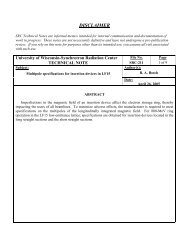SRC Users' Meeting - Synchrotron Radiation Center - University of ...
SRC Users' Meeting - Synchrotron Radiation Center - University of ...
SRC Users' Meeting - Synchrotron Radiation Center - University of ...
You also want an ePaper? Increase the reach of your titles
YUMPU automatically turns print PDFs into web optimized ePapers that Google loves.
INTERACTIONS IN THE PHOTOEMISSION PROCESS OF<br />
MATERIALS WITH LOW CONDUCTIVITY<br />
Christian R. Ast<br />
Max-Planck-Institut für Festkörperforschung, Stuttgart, Germany<br />
Scattering <strong>of</strong> the photoelectron is an omnipresent phenomenon in photoemission<br />
spectra. In most cases inelastic scattering manifests itself in either discrete loss structures,<br />
a featureless background or an asymmetric line shape. Two examples are presented in<br />
which increased interactions <strong>of</strong> the photoelectron with its surroundings lead to additional<br />
emission features in the photoemission spectra <strong>of</strong> the semimetal bismuth. Scattering<br />
events can be seen in core level spectra as structured loss features from interband<br />
transitions. In valence band spectra, scattering processes can contribute additional<br />
structures from secondary cone emission.<br />
Spectra <strong>of</strong> the Bi 5d core level show an additional peak split <strong>of</strong>f in energy<br />
between 160 and 260meV, which can be related to momentum dependent energy losses<br />
suffered by the photoelectron from interband transitions. Similar phenomena have been<br />
observed in the 4d core levels <strong>of</strong> Sb, which leads to the conclusion that loss features are<br />
enhanced in materials with low conductivity and low charge carrier concentration.<br />
Valence band spectra <strong>of</strong> Bi(111) at normal emission as a function <strong>of</strong> photon energy show<br />
multiple emission features from the same initial state band. These emission features can<br />
be attributed to primary and secondary cone emission. To be observed in the normal<br />
emission spectra photoelectrons from secondary cone emission have to be scattered back<br />
into the normal emission direction. Accounting for the secondary cone emission in the<br />
analysis <strong>of</strong> the final state dispersion, it is than possible to experimentally determine the<br />
deviations <strong>of</strong> the final states from the free electron band structure. With these<br />
experimentally determined final state bands on hand, it is than possible to extract the<br />
initial state band structure E i (k).
















